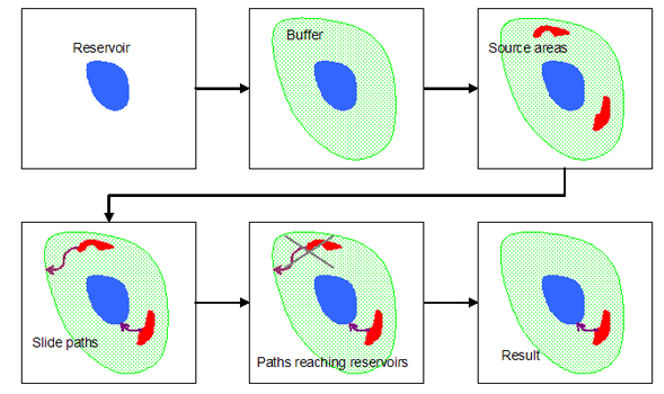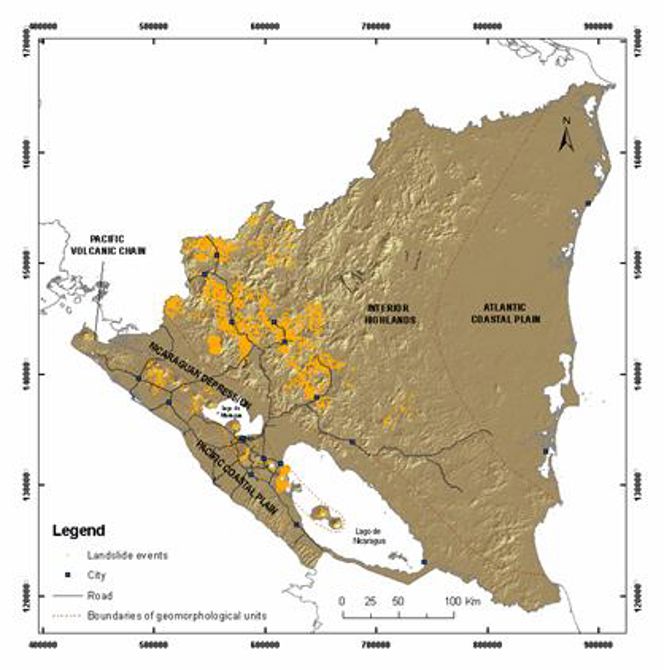Recent results
This section includes results from the following: • Rock slide risk in water Magazines • Landform classification and contextual merging • Global hotspots in the landslide and avalanche hotspots • Statistical analysis of Nicaraguan landslides.
Rock slide risk in water magazines A model for regional analysis was developed within the framework of the ESRI ArcGIS software. The objective of the model was to give a quick overview of the potential intersection between rock slide hazards and dammed lakes in Norway. As input data for the analysis, we used a 25*25 m digital elevation model (DEM), produced by the Norwegian mapping authority (Statens Kartverk) and a map layer with all reservoirs in Norway, provided by Norwegian Water Resources and Energy Directorate (NVE).
Due to the considerable amount of data that needed to be processed (62 grids of up to 4000*4000 cells) the method needed to be computationally effective. Four simple criteria were set up for the analysis:
- the horizontal distance a slide can traverse has a maximum limit (of 2 km)
- source areas for rockslides require a certain steepness (50 degrees)
- once released, slides will follow the steepest downward path
- the slide height/length ratio (H/L) has a minimum limit (of 0.2)
According to the analysis, about 50% of all reservoirs in Norway have potential rock slide interception. This number seems disturbingly high, but one must remember that degree of slope alone has been used as input in the analysis and the criteria for defining source areas is therefore far too inclusive. What the number really tells us is that rock slides may be discarded as a hazard for the remaining half of the reservoirs due to their topographical setting.

Figure 7. Simple sketch of the steps in the GIS model.
The reservoirs with potential rock slide hazards were approximately equally distributed among the dam breach hazard classes. Geographically the reservoirs were clustered in the western counties from Rogaland to Møre og Romsdal, but also Telemark, Oppland, and Nordland had more than 40 of the reservoirs each. The figure below points out hot-spot municipalities (such as Bremanger, Høyanger, and Odda) where the number of reservoirs with potential rock slide hazards is especially high.
Landform classification and contextual merging Automatic classification of terrain attributes into meaningful morphological units have great potential within the field of general geomorphology. When applying common classification algorithms such as iterative cluster analysis to terrain data, the result is often a set of classes with a marked lack of coherence in geographical space. The scattering of classes occurs because there is an authentic overlap between different classes in both attribute and geographical space. Therefore other procedures should be used for relief structuring that takes the class overlap into account. Such a procedure could be the application of a preliminary segmentation, or generalization in geographical space, prior to classification.
In the first study, we assess the performance of the method for delineation of specific landforms such as talus cones and chutes in a limited area near Ny-Ålesund, Spitsbergen, and it is shown that the coherence and interpretability of the result is increased compared to a simple cluster analysis alone. In the second study, we apply the method for a regional landscape classification of Southern Norway and discuss how the resulting classes relate to the general geomorphological processes involved in shaping the landscape.
Global hotspots in landslide and avalanche hotspots
Allocating resources for natural hazard risk management has high priority in development banks and international agencies working in developing countries. Global hazard and risk maps for landslides and avalanches were developed to identify the most exposed countries. Based on the global datasets of climate, lithology, earthquake activity, and topography, areas with the highest hazard, or "hotspots", were identified.
The applied model was based on classed values of all input data. The model output is a landslide and avalanche hazard index, which is globally scaled into nine levels. The model results were calibrated and validated in selected areas where good data on slide events exist.
The results from the landslide and avalanche hazard model together with global population data were then used as input for the risk assessment. Regions with the highest risk can be found in Colombia, Tajikistan, India, and Nepal where the estimated number of people killed per year per 100 km2 was found to be greater than one.
The model made a reasonable prediction of the landslide hazard in 240 of 249 countries. More and better input data could improve the model further. Future work will focus on selected areas to study the applicability of the model on national and regional scales.
Landslide database for Nicaragua
(in cooperation with ICG SP 9 and INETER)
A national landslide database was developed for Nicaragua within the framework of ArcGIS and SQL server. The objective is to collect all available information on landslide events from historical documents, technical reports, and landslide inventory maps prepared after Hurricane Mitch, in order to analyze and evaluate the landslide hazards in the country. Historical and recent events are available in the form of spatial and thematic data.
The data stored in the database have been analyzed at the national scale to:
- define the distribution, types of mass movement, and triggering mechanisms of historical landslide events that occurred before 1990
- define all landslide events their spatial and temporal distribution, most important triggering factors, and relation with other natural hazards
- identify in selected areas the relevant topographic parameters such as elevation, slope angle, slope aspect, derivable from digital terrain models and compare with data obtained from field observations.

Figure 14. Spatial distribution of landslide events recorded in the national database and geomorphological units
Statistical analysis of Nicaraguan landslides
(in cooperation with ICG project 9)
Selected data available in the database are being used to analyze, through empirical-statistical methods, the relationships between the most important parameters of debris flows in order to predict runout distances, necessary for debris flow hazards assessment.
The relations proposed will be compared with similar relationships available in the literature and used to calibrate numerical simulation models.